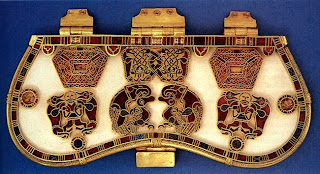As you may have heard by now, a few months back a metal-detecting enthusiast hit the mother lode in Staffordshire. Instead of bottle caps and old nails, the urgent pinging of his detector signaled a buried cache of Anglo-Saxon gold consisting mostly of war booty–sword fittings, decorative armor clasps and panels, and some jewelry–probably from the end of the seventh or the beginning of the eighth centuries . This find was, to put it simply, seriously awesome, if not quite as revolutionary and convention-wisdom-upon-its-head-turning as the breathless copy at the website for the newly-dubbed “Staffordshire Hoard” might suggest.
Given my usual proclivities, it should come as no surprise that the chief point of interest for me are the weird stylized animals that decorate the items from the hoard. Like these guys, found around the edge of a golden dagger hilt:

Though to our eyes they probably look more like four-legged eels or duck-billed monsters, these synchronized leg-biting animals are probably wolves. Here, I’ve isolated one wolf* for you:

And with the body parts labeled:

(If I were better at Photoshop, this would be a more compelling demonstration.)
I single out the wolves for attention primarily because there’s some discussion going on out there in the wider internet–particularly in the comments on the hoard’s Flickr page–about this other image, which is found on a folded-up brooch in the hoard:

Some people see a person’s crossed arms when they look at this, others a pair of fish or eels, still others ouroborusian serpents. There’s even one hopeful commenter out there arguing that it’s meant to represent Odin’s two ravens Huginn and Muniin.
If you glance back up at the labeled picture above, it’s clear what it is: a foreleg and paw attached directly to a snout that’s chewing on an identical foreleg and paw attached directly to a snout that is chewing right back. In other words, it’s a bit of visual nonsense made up out of isolated elements of the highly stylized seventh- and eighth-century decorative vocabulary.
Of course, when we’re confronted with visual nonsense, our brains try to sort it into sense, which is probably why there are so many different explanations of what the brooch-images are meant to be. Indeed, that might be the reason migration era artists liked to created these mish-mashes of stylized body-parts, the stimulating mental dissonance of unresolvable visual puzzles and the accompanying pleasant “click” feeling when the brain (temporarily) resolves them.
Interestingly, what I’m calling “stylized visual nonsense” is a feature that characterizes earlier migration-era art. As time goes on, these clever bits of wonkiness fall out of fashion in favor of less-stylized, more realistic depictions of animals. I say it’s interesting because hyper-stylized abstract play is something I’ve always (unreasonably, granted) associated with post-modern art–and I don’t think I’m alone on this. It’s easy to construct a satisfying narrative for it: first people drew what they saw (realism), then they started experimenting and got bolder and more experimental (cubism, surrealism, etc.), no longer bound by the tyranny of representationalism. But with the Anglo-Saxons and Celts of the sixth, seventh, and eighth centuries, art gradually lost its experimental abstract character and slowly became, for lack of a better term, “square,” even conservative.
I also should point out that transition is not mine; Bernhard Salin formally classified the stages back in the nineteen aughts and teens. Weird stylized animal he calls “Style I” animal art, which lasts from the fifth-century to the beginning of the seventh or so. “Style II” follows and lasts until middle of the eighth or so; it’s characterized by figures that become more realistic and which are counterpoised in symmetrical arrangements.
The Sutton Hoo ship burial contains pieces that were made during the transition between Styles I and II. Like this purse lid:

Up top and in the middle you still have stylized interlocked wolfy figures, but down below and on either side, you get more realistic looking animals posed in balanced arrangements. And as time goes on, the animals get more and more realistic until the abstract character drops away entirely and you basically have figural carvings decorating things (which Salin calls, predictable, “Style III”).
So, essentially, during the Anglo-Saxon era in England, there came a point where hyper-stylized abstract art became “old-fashioned”–the sort of thing old men might still have on their swords, or old ladies on their brooches, but which the kids rolled their eyes at in favor of things that looked more like things (to borrow a line from Terry Pratchett). Kinda like how on the old Max Headroom TV show, set “twenty minutes in the future,” all the punk rockers with mohawks and leather chaps and safety pins in their noses were old men.
—
*Or, possibly a lion or a domesticated dog. But I’m going to keep saying “wolf” instead of “wolf or lion or dog” for the remainder of the post.